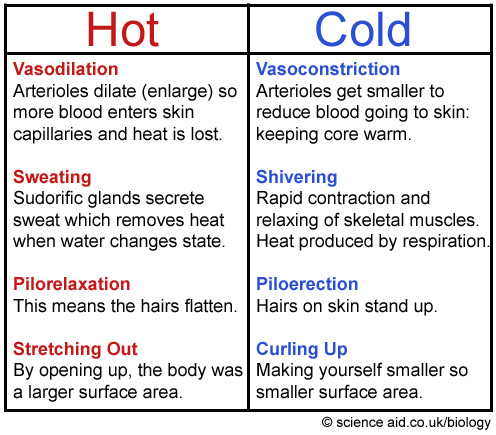Behavioral and Physiological Responses
To try to maintain equilibrium, the body responds, which I'd physiological, but
something’s from humans there is a behavioural response. A behavioural response
entails the actions and interactions of the person to try to maintain a balance
in the internal body system. For example a behavioural response in the
circumstances that its cold, a behavioural response would be to put on a jumper,
have a hot drink or put a heater on. These things the body doesn’t do one their
own. whereas a physical response to the cold would be coetaneous
vasoconstriction (blood vessels constrict, minimising blood flow to the skin
which minimises heat loss, making the person paler. Skeletal muscles will be
activated to constrict which is known as shivering), goose bumps and shivering.
In instance that it is hot an example of a behavioural response would be to
take a jumper off, have a cold drink, stand in front of the fridge, or turn on
the air-conditioning. a physiological response would be sweating, or coetaneous
vasodilatation (blood vessels that will dilate to give off heat making the skin
look flushed), also acclimatization (thyroid and adrenals will secrete less
thyroxin and adrenaline to lower the metabolism).
(Homeostasis,©Westone services).
something’s from humans there is a behavioural response. A behavioural response
entails the actions and interactions of the person to try to maintain a balance
in the internal body system. For example a behavioural response in the
circumstances that its cold, a behavioural response would be to put on a jumper,
have a hot drink or put a heater on. These things the body doesn’t do one their
own. whereas a physical response to the cold would be coetaneous
vasoconstriction (blood vessels constrict, minimising blood flow to the skin
which minimises heat loss, making the person paler. Skeletal muscles will be
activated to constrict which is known as shivering), goose bumps and shivering.
In instance that it is hot an example of a behavioural response would be to
take a jumper off, have a cold drink, stand in front of the fridge, or turn on
the air-conditioning. a physiological response would be sweating, or coetaneous
vasodilatation (blood vessels that will dilate to give off heat making the skin
look flushed), also acclimatization (thyroid and adrenals will secrete less
thyroxin and adrenaline to lower the metabolism).
(Homeostasis,©Westone services).

